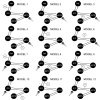Network modulation during complex syntactic processing
- PMID: 21820518
- PMCID: PMC3195988
- DOI: 10.1016/j.neuroimage.2011.07.057
Network modulation during complex syntactic processing
Abstract
Complex sentence processing is supported by a left-lateralized neural network including inferior frontal cortex and posterior superior temporal cortex. This study investigates the pattern of connectivity and information flow within this network. We used fMRI BOLD data derived from 12 healthy participants reported in an earlier study (Thompson, C. K., Den Ouden, D. B., Bonakdarpour, B., Garibaldi, K., & Parrish, T. B. (2010b). Neural plasticity and treatment-induced recovery of sentence processing in agrammatism. Neuropsychologia, 48(11), 3211-3227) to identify activation peaks associated with object-cleft over syntactically less complex subject-cleft processing. Directed Partial Correlation Analysis was conducted on time series extracted from participant-specific activation peaks and showed evidence of functional connectivity between four regions, linearly between premotor cortex, inferior frontal gyrus, posterior superior temporal sulcus and anterior middle temporal gyrus. This pattern served as the basis for Dynamic Causal Modeling of networks with a driving input to posterior superior temporal cortex, which likely supports thematic role assignment, and networks with a driving input to inferior frontal cortex, a core region associated with syntactic computation. The optimal model was determined through both frequentist and Bayesian Model Selection and turned out to reflect a network with a primary drive from inferior frontal cortex and modulation of the connection between inferior frontal cortex and posterior superior temporal cortex by complex sentence processing. The winning model also showed a substantive role for a feedback mechanism from posterior superior temporal cortex back to inferior frontal cortex. We suggest that complex syntactic processing is driven by word-order analysis, supported by inferior frontal cortex, in an interactive relation with posterior superior temporal cortex, which supports verb argument structure processing.
Copyright © 2011 Elsevier Inc. All rights reserved.
Figures






Similar articles
-
The role of left temporo-parietal and inferior frontal cortex in comprehending syntactically complex sentences: A brain stimulation study.Neuropsychologia. 2023 Feb 10;180:108465. doi: 10.1016/j.neuropsychologia.2022.108465. Epub 2022 Dec 28. Neuropsychologia. 2023. PMID: 36586718
-
Neural processing during older adults' comprehension of spoken sentences: age differences in resource allocation and connectivity.Cereb Cortex. 2010 Apr;20(4):773-82. doi: 10.1093/cercor/bhp142. Epub 2009 Aug 7. Cereb Cortex. 2010. PMID: 19666829 Free PMC article.
-
Who did what to whom? The neural basis of argument hierarchies during language comprehension.Neuroimage. 2005 May 15;26(1):221-33. doi: 10.1016/j.neuroimage.2005.01.032. Neuroimage. 2005. PMID: 15862222 Clinical Trial.
-
Correlations and brain states: from electrophysiology to functional imaging.Curr Opin Neurobiol. 2009 Aug;19(4):434-8. doi: 10.1016/j.conb.2009.06.007. Epub 2009 Jul 15. Curr Opin Neurobiol. 2009. PMID: 19608406 Free PMC article. Review.
-
Hierarchical Structure in Sequence Processing: How to Measure It and Determine Its Neural Implementation.Top Cogn Sci. 2020 Jul;12(3):910-924. doi: 10.1111/tops.12442. Epub 2019 Jul 30. Top Cogn Sci. 2020. PMID: 31364310 Free PMC article. Review.
Cited by
-
Verb and sentence processing patterns in healthy Italian participants: Insight from the Northwestern Assessment of Verbs and Sentences (NAVS).J Commun Disord. 2019 May-Jun;79:58-75. doi: 10.1016/j.jcomdis.2019.03.001. Epub 2019 Mar 6. J Commun Disord. 2019. PMID: 30884288 Free PMC article.
-
Connectivity of Fronto-Temporal Regions in Syntactic Structure Building During Speaking and Listening.Neurobiol Lang (Camb). 2024 Oct 8;5(4):922-941. doi: 10.1162/nol_a_00154. eCollection 2024. Neurobiol Lang (Camb). 2024. PMID: 39439740 Free PMC article.
-
Evolution of the neural language network.Psychon Bull Rev. 2017 Feb;24(1):41-47. doi: 10.3758/s13423-016-1090-x. Psychon Bull Rev. 2017. PMID: 27368631 Free PMC article.
-
Hierarchy processing in human neurobiology: how specific is it?Philos Trans R Soc Lond B Biol Sci. 2020 Jan 6;375(1789):20180391. doi: 10.1098/rstb.2018.0391. Epub 2019 Nov 18. Philos Trans R Soc Lond B Biol Sci. 2020. PMID: 31735144 Free PMC article. Review.
-
Grounding the neurobiology of language in first principles: The necessity of non-language-centric explanations for language comprehension.Cognition. 2018 Nov;180:135-157. doi: 10.1016/j.cognition.2018.06.018. Epub 2018 Jul 24. Cognition. 2018. PMID: 30053570 Free PMC article. Review.
References
-
- Ben-Shachar M, Hendler T, Kahn I, Ben-Bashat D, Grodzinsky Y. The neural reality of syntactic transformations: evidence from functional magnetic resonance imaging. Psychol Sci. 2003;14(5):433–440. - PubMed
-
- Benjamini Y, Hochberg Y. Controlling the false discovery rate: a practical and powerful approach to multiple testing. Journal of the Royal Statistical Society, Series B. 1995;57:289–300.
-
- Bornkessel I, Zysset S, Friederici AD, von Cramon DY, Schlesewsky M. Who did what to whom? The neural basis of argument hierarchies during language comprehension. Neuroimage. 2005;26(1):221–233. - PubMed
-
- Bornkessel-Schlesewsky I, Schlesewsky M, Cramon D. Y. v. Word order and Broca’s region: Evidence for a supra-syntactic perspective. Brain and Language. 2009;111(3):125–139. - PubMed
Publication types
MeSH terms
Grants and funding
LinkOut - more resources
Full Text Sources

